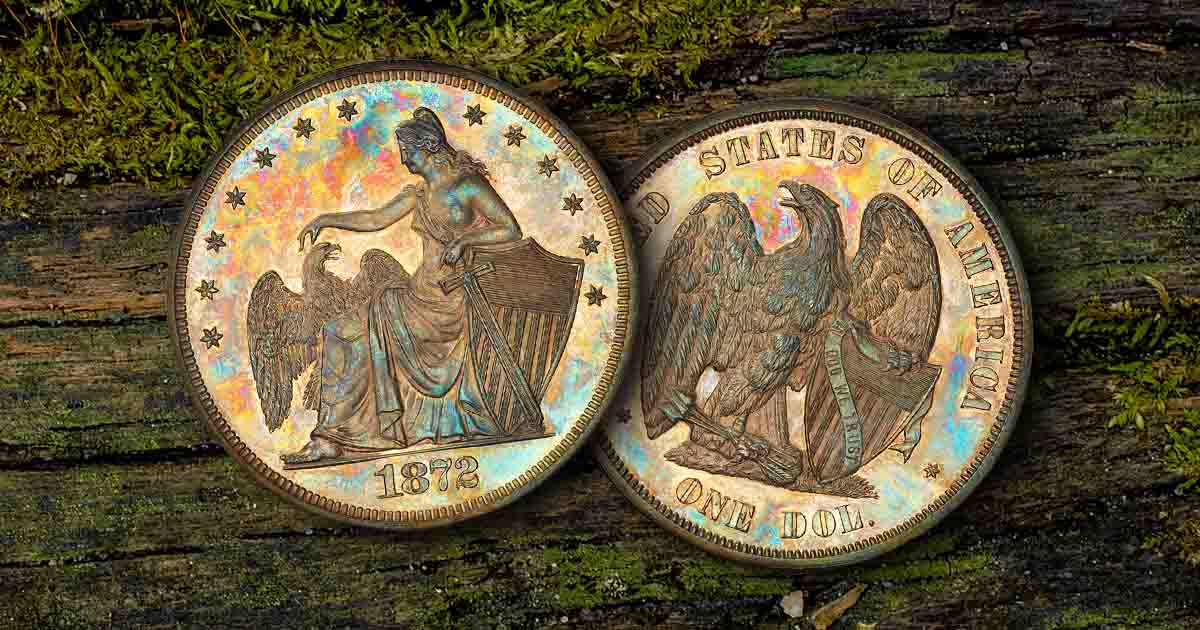
The Amazonian pattern dollar was an 1872 pattern coin designed by William Barber that featured Liberty as a warrior.
Who was William Barber?
William Barber was the fifth Chief Engraver of the United States Mint, not to be confused with his son, Charles E. Barber, who served as the sixth Chief Engraver of the Mint. William Barber succeeded James B. Longacre at the Mint as Chief Engraver and was appointed by Andrew Johnson.
Today, William Barber is best known for his Trade dollar design, which was produced between 1873 and 1878.
The Pattern War Between William Barber and George T. Morgan
The 1870s were a period of transition in the United States. The nation was recovering from the Civil War and experiencing growth and industrialization. In the face of the changing environment, the U.S. Mint was exploring new designs. Internally, William Barber was engaged in a pattern war with George T. Morgan, the future 7th Chief Engraver at the Mint. Morgan and Barber had divergent views on the artistic direction of U.S. coins. Each engraver produced various pattern coins designed to replace existing coins.
The patterns were primarily produced to showcase trial designs to members of Congress, the Treasury Department, and prominent collectors for feedback. Since pattern coins illustrate a new concept for a small number of people, they are struck in limited quantities, which contributes to their demand and value.
William Barber’s Patterns
William Barber’s patterns at this time included the famous Trade dollar, the Amazonian Pattern dollar, and his Metric patterns. The Metric patterns represented Barber’s experimentation with metric coinage, but those designs did not gain favor like the Trade and Amazonian dollar patterns did.
George T. Morgan’s Patterns
Some of George T. Morgan’s patterns include the Coiled Hair Stella and the timeless Morgan silver dollar, although his pattern was initially produced as a half dollar.
Design of the 1872 Amazonian Pattern
The Amazonian patterns were produced in silver, gold, copper, and even aluminum. There was a separate obverse design used for the gold issue that only featured a bust of Liberty. Although the design was modified for the half dollar, quarter dollar, $10, and $20 denominations, it was never circulated and remained a pattern. One of the reasons for this was that Liberty did not feature the word LIBERTY, nor did she carry an olive branch. She was furthermore viewed as being too militaristic for an issue on a U.S. coin.
Obverse of the Amazonian Pattern
The obverse of this pattern depicts a relaxed and bare chested Liberty, who is seated facing left and wearing a Phrygian cap. She is resting her left arm on a large shield, and her left hand is relaxed but holds the hilt of a sword up with its blade on the ground. Her right hand is nearly touching the head of an eagle standing on the ground next to her. The date is below her and there are thirteen stars surrounding her along the rim of the coin. The Amazonian name refers to her bare breasts and long sword, which contrast boldness with tenderness as she gently reaches for the head of the eagle.
Reverse of the Amazonian Pattern
The reverse of the Amazonian pattern features a striking eagle who is facing left. The eagle’s right foot grasps three arrows and its left foot holds up a smaller version of the shield Liberty rests her left arm on. There is a banner hanging over the shield that reads IN GOD WE TRUST. The words UNITED STATES OF AMERICA are inscribed above and around the eagle, which is flanked by one star on each side, and the words ONE DOL beneath the eagle.
How Valuable is the 1872 Amazonian Pattern Dollar?
As a result of its low population of coins, the Amazonian pattern dollar is valuable in all conditions and is especially valuable in higher grades. One struck in silver graded as PR-64 CAM was sold for $186,000 in May of 2023.




